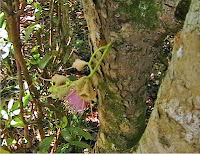Hybridization between
species is rare in animals, but a fairly common occurrence in many
plants, with related plant species often having hybridization zones
between populations of related parent species. How such hybridization
zones occur without the two species is a subject of ongoing
discussion among botanists, with three main theories having emerged.
The Tension Zone theory suggests that the hybrids are less
genetically fit than either parent species, but that the
hybridization zone persists because there is no bar to hybridization
between the two parent species, so that new hybrids are constantly
produced, even if these do not thrive and reproduce. The Bounded
Hybrid Superiority Theory suggests that the hybrids are unfit in the
habitats favored by their parent species, but that they are more fit
than their parents in the habitat where they occur, enabling them to
thrive in a specific environment that the parents do not colonize;
this theory allows for a thriving hybrid population even if the
hybrids are sterile. Mosaic Hybridization is thought to occur where
two species have an overlapping ranges containing a patchwork of
different environments; in such circumstances a range of hybrid
species can co-exist with the parents, each being suited to a
different habitat.
In
a paper published in the journal BMC Plant Biology on 18 April 2016,
Dechun Jiang of the State Key Laboratory of Grassland Agro-Ecosystem
at Lanzhou University, Jianju Feng, also of the State Key Laboratory
of Grassland Agro-Ecosystem at Lanzhou University and of the College
of Plant Sciences of the Xinjiang Production & Construction Corps
and the Key Laboratory of Protection and Utilization of Biological
Resources in Tarim Basin at Tarimu University, and Miao Dong, Guili
Wu, Kangshan Mao and Jianquang Liu, all of the State Key Laboratory
of Grassland Agro-Ecosystem at Lanzhou University, discuss the origin
of a naturally occurring hybrid Poplar, Populus
× jrtyschensis, from
Xinjiang Province in northwest China.
Poplars, Populus
spp.,
(also known as Aspens and Cottonwoods) are a widespread group of
flowering trees in the Willow Family (Salicaceae),
known for producing a range of hybrids, with a number of established
trees in the genus also thought to have originated as hybrids.
Hybridization in Poplars has previously been studied in Europe and
North America, but the phenomenon has to date been little studied in
Asia. Populus ×
jrtyschensis occurs
naturally on the floodplains of the Erqis River in the north of
Xinjiang Province, where it forms forests in which neither of its
presumed parent species is present. The species is also widely
planted along agricultural drainage channels, being easily cultivated
as a clone from cuttings.
Foliage of Populus ×
jrtyschensis. eFlora/Flora of China.
It
is thought to be a hybrid of two distantly related species, the Black
Poplar, Populus
nigra,
which is found from Europe and northwest Africa east to Central Asia,
and which favors wet slopes near rivers at altitudes of 400-1000 m,
and the Laurel-leafed Poplar, Populus
laurifolia,
which is found in Northern Asia south into parts of Central Asia, and favors dry slopes in the mountainous parts of river valleys, occurring from 400-1800 m, these tow species co-concurring in parts of
Xinjiang Province. Although these species prefer different
environments, they flower at the same time of year, April-May, and
are wind-pollinated as well as having wind-distributed seeds, leading
to the possibility of both hybridization and the colonization of
environments not favored by either parent by the resulting hybrid
young.
A Black Poplar, Populus nigra. L'Orto botanico d'Italia.
Jiang
et al.
took chloroplast and nuclear DNA samples from 566 trees from 45
different populations of the three different species in order to
determine their relationships. They found that the chloroplast DNA
(which is passed only through the female line) of Populus
nigra and
Populus laurifolia
were
easily distinguished, with 94% of Populus
× jrtyschensis trees
having Populus
laurifolia
chloroplast DNA (indicating descent from a female Populus
laurifolia plant)
and the remaining 6% having Populus
nigra chloroplast
DNA. Sequencing of the nuclear DNA of Populus
× jrtyschensis suggested
that 84% of these trees were first generation hybrids between parents
of the two other species, while 6% were crosses between first
generation hybrids and one of the parent species, and 10% were more
difficult to ascribe parental backgrounds. Two trees were found to be
clones, suggesting that one or both had grown vegetatively from a
detached part of a first generation hybrid.
This
suggests strongly that the population of Populus
× jrtyschensis is
maintained by a continuous supply of new hybrids between (usually
male) Populus
nigra
and (usually female) Populus
laurifolia flowers
(Poplars
usually produce separate male and female flowers on the same tree),
with the trees themselves apparently having low fertility. However
they had a distinct ecological niche, separate to that favored by
either parent, growing on the floodplains of river valleys rather
than higher on the side slopes. Examination of the sites where these
trees grew revealed that the soil in which they grew also had far
lower nitrogen levels than could normally be tolerated by either
parent species, re-enforcing the idea that these trees have a unique
ecological niche.
See also...
 Prunus kunmingensis: Peaches from the Late Pliocene of Yunnan Province. Peaches, Prunus persica, are widely grown and consumed fruit
around the world today, with a total annual production of about 20
million tons. They have a long historical association with humans,
particularly in East Asia, with the oldest known...
Prunus kunmingensis: Peaches from the Late Pliocene of Yunnan Province. Peaches, Prunus persica, are widely grown and consumed fruit
around the world today, with a total annual production of about 20
million tons. They have a long historical association with humans,
particularly in East Asia, with the oldest known...
 Syzygium pyneei: A new species of Myrtle from Mauritius. The genus Syzygium is the
largest within the Myrtle family, Myrtaceae, with over 1200 described species from
across the tropical and subtropical regions of the Old World, including fifteen
previously described species from Mauritius.
Syzygium pyneei: A new species of Myrtle from Mauritius. The genus Syzygium is the
largest within the Myrtle family, Myrtaceae, with over 1200 described species from
across the tropical and subtropical regions of the Old World, including fifteen
previously described species from Mauritius.
 A new species of Rhododendron from Guizhou Province, China. Rhododendrons, Rhododendronspp., are a large group of flowering shrubs and trees found in East and
Southeast Asia and across Indonesia to northern Australia, and widely
introduced elsewhere...
A new species of Rhododendron from Guizhou Province, China. Rhododendrons, Rhododendronspp., are a large group of flowering shrubs and trees found in East and
Southeast Asia and across Indonesia to northern Australia, and widely
introduced elsewhere...
See also...
 Prunus kunmingensis: Peaches from the Late Pliocene of Yunnan Province. Peaches, Prunus persica, are widely grown and consumed fruit
around the world today, with a total annual production of about 20
million tons. They have a long historical association with humans,
particularly in East Asia, with the oldest known...
Prunus kunmingensis: Peaches from the Late Pliocene of Yunnan Province. Peaches, Prunus persica, are widely grown and consumed fruit
around the world today, with a total annual production of about 20
million tons. They have a long historical association with humans,
particularly in East Asia, with the oldest known...  Syzygium pyneei: A new species of Myrtle from Mauritius. The genus Syzygium is the
largest within the Myrtle family, Myrtaceae, with over 1200 described species from
across the tropical and subtropical regions of the Old World, including fifteen
previously described species from Mauritius.
Syzygium pyneei: A new species of Myrtle from Mauritius. The genus Syzygium is the
largest within the Myrtle family, Myrtaceae, with over 1200 described species from
across the tropical and subtropical regions of the Old World, including fifteen
previously described species from Mauritius. A new species of Rhododendron from Guizhou Province, China. Rhododendrons, Rhododendronspp., are a large group of flowering shrubs and trees found in East and
Southeast Asia and across Indonesia to northern Australia, and widely
introduced elsewhere...
A new species of Rhododendron from Guizhou Province, China. Rhododendrons, Rhododendronspp., are a large group of flowering shrubs and trees found in East and
Southeast Asia and across Indonesia to northern Australia, and widely
introduced elsewhere...
Follow Sciency Thoughts on Facebook.



